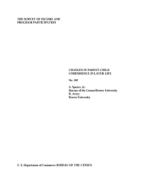Changes in Parent-Child Coresidence in Later Life
Changes in Parent-Child Coresidence in Later Life
Abstract
The coresidence of older parents and their adult children is viewed both from the perspective of the parent and the child using data from three panels of the Survey of Income and Program Participation. The analysis focuses only on older children, those 25 and older, to exclude cases of extended dependency due to college enrollment or initial labor force entry.
Persons aged 55 and over were most likely to live with older children if they lacked economic resources of their own or needed help with activities of daily living. Controlling these needs, coresidence declined with age until age 85, when it increased again and was much more likely for unmarried persons than married persons-. The likelihood of coresidence also increased significantly with the number of children one had.
Children aged 25 and over were also more likely to live with parents if the children had low incomes or needed help with activities of daily living, if they did not own a house and if they did not have a child of their own. Coresidence was much more likely for unmarried persons and it declined significantly with age. For both parents and children, coresidence was much more common among Asians than any other racial group.
Transitions to and from coresidence were also examined over four month time intervals from both the child's and parent's perspective. In general, the determinants of these transitions corresponded to the determinants of living arrangements at a fixed point in time. Overall the changes in coresidence seemed to be more responsive to the needs of the children than the needs of the parents.
Others in Series
Working Paper
Working Paper
Working Paper




